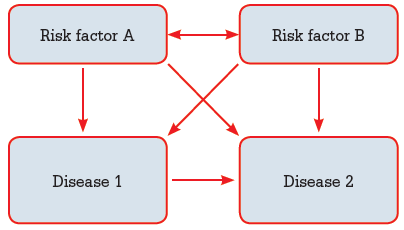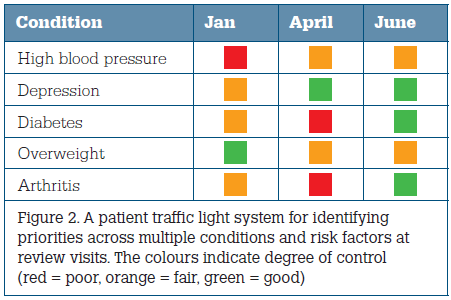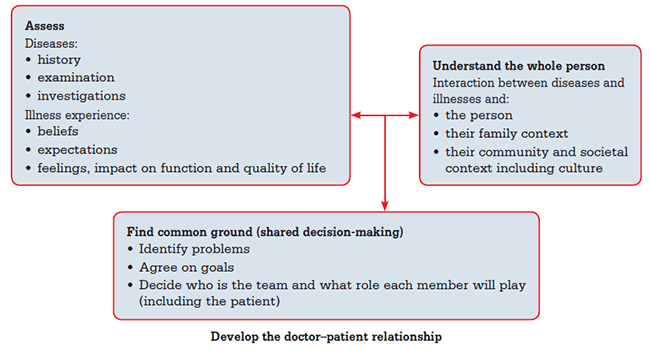Multimorbidity may present as a collection of long-term conditions that share common risk factors (eg. chronic obstuctive pulmonary disease and cardiovascular disease as a result of smoking) or when one condition leads to another as a complication (eg. diabetes and cardiovascular disease; Figure 1). For some, multiple conditions may be unrelated and occur by chance simply because of the increasing prevalence of chronic diseases in the ageing population.

Figure 1. Associations and interactions between risk factors and diseases1
Multimorbidity has a significant effect on patients’ lives. Quality of life for people with multimorbidity is inversely related to the number of conditions they have and the extent of any disability.6,7 For example, the amount of time that people with several long-term conditions must spend managing their health can be as high as 5–8 hours per day.8 Multimorbidity reduces the capacity of patients to modify their lifestyle, their ability to seek help and to manage multiple medications.9 It also has a significant economic impact on patients because of the costs associated with their care, which may be compounded by their inability to work as the conditions progress.
Multimorbidity is also challenging for health professionals in planning good quality care. Not only can the conditions themselves influence each other but their treatments may interact and there may also be interactions between the conditions and treatment. For example, medications for epilepsy may cause increased appetite and reduce exercise tolerance, leading to weight gain and development of obesity. This creates a significant demand on general practitioners’ time because of the need to identify and negotiate priorities. Management of one chronic illness may also occur at the expense of another clinically important behaviour; an example might be ensuring medication adherence for hypertension at the expense of lifestyle change such as weight reduction and exercise (see case study). Priority setting is thus critical for both patients and providers.
Case study
A woman, aged 81 years, with osteoporosis, osteoarthritis, cardiac failure, atrial fibrillation, depression and hypertension takes eight different medications each day. She is required to limit her fluid intake, weigh herself daily, take precautions to prevent falls, avoid certain foods and over-the-counter medications, and do muscle-strengthening exercises. She receives care from her general practitioner, cardiologist, endocrinologist, rheumatologist, physiotherapist, podiatrist and cardiac nurse, and has home care assistance with shopping. However, barriers have impeded effective communication between the providers and this has contributed to fragmentation of her care, inconsistent information given to her and poor outcomes.
At regular review visits, the general practitioner and practice nurse work with the patient to identify priorities and goals on the basis of what will contribute most in lowering risk and improving function in her daily life. They make a real effort to give her some sense of control over her life. They also try to coordinate across the complex group of providers not only through agreed annual care plans but also patient-held charts (Figure 2) and regular phone contact.

Figure 2. A patient traffic light system for identifying priorities across multiple conditions and risk factors at review visits. The colours indicate degree of control (red = poor, orange = fair, green = good)
Principles of management
So how should multimorbidity be managed in general practice? Guidelines and treatment algorithms for single conditions may not be very helpful. Their recommendations are often based on research involving patients with single conditions; in fact those with multimorbidity are often excluded from the studies. This gives rise to situations where the guidelines may conflict with a holistic approach to the patient’s problems.
Addressing multiple single conditions is difficult and time consuming. Most clinicians see additional morbidities as adding to the total burden of care for both the patient and provider.10 It places pressure on the consultation and forces the prioritisation of conditions and treatments, which results in the frequent carry-over of management issues to subsequent consultations or failure to address conditions lower down the list of priorities.
Clinicians need to decide where to focus their attention first. For example, would managing a patient’s depression help in the management of type 2 diabetes in a patient with both conditions? Depression is common in patients with diabetes and those with both conditions have poorer glycaemic control and are more likely to develop complications than people with diabetes who are not depressed.11 However, somewhat counter-intuitively, treating depression has not been found to necessarily improve self-management or control of diabetes (although it may improve overall quality of life).12 Thus we need to be careful about assuming that patient self-management behaviours will act synergistically to improve single-disease outcomes. Focusing on the contribution each condition makes, singly or in combination, to the ability of the patient to function in daily life may help in this prioritisation.
Assessment
One of first tasks when managing multimorbidity is to understand how the conditions contribute and interact to affect the patient’s physical, psychological and social functioning. It is also important to provide a holistic assessment of the risks and benefits of various strategies to address the patient’s multiple conditions. This then forms the basis of the information given to the patient and leads to negotiation of individualised goals and priorities tailored to their agenda, which is the essence of patient-centred medicine.
There is also evidence that the number of conditions can be a greater determinant of a patient’s need and use of health service resources than the presence of specific diseases.13 A single-disease approach is well suited to the management of acute illnesses but less well suited to the current challenge with chronic multimorbidity.
Negotiating with patients
Care for patients with multimorbidity should aim to be responsive to the patient’s own concerns, with patients being actively involved in setting of their goals and priorities.14 This includes involvement in setting the agenda for what is addressed in their consultations. The ‘patient-centred clinical method’ (Figure 3) recommends that patients be asked how they feel about their illness, about its effect on their function and their expectations of medical care.15

Figure 3. Patient-centred clinical method15
Common ground needs to be found between the disease-specific targeted approach and the patient’s concern for their ability to function in their daily life. This is sometimes seen as a conflict but it need not be so, especially in the context of long-term continuity of care in general practice.16
This partnership between health providers, patients, their carers and social networks is more effective where the provider recognises that the person can be an expert in their own condition.17 The patient is supported to develop the knowledge and skills to take an active role in self-management and to achieve their health goals in partnership with their health care team, peers and families.18 However if there are too many different tasks, multimorbidity may overwhelm a patient’s capacity to self-manage. Too many people in the multidisciplinary team and poor communication mean that patients with chronic conditions struggle to manage their health, especially if the advice and information they receive is conflicting and leaving them confused.19 This presents a dilemma for the clinician. It may be partly addressed by focusing on conditions that are not well controlled or those that put the patient most at risk (Figure 2).
Management of risk factors
An obvious place to start is in taking an integrated approach to the management of common risk factors. The smoking, nutrition, alcohol, physical activity and weight (SNAPW)20 risk factors are common to most chronic diseases and their management is a key part of the prevention and control of the disease process. The 5As framework provides a common pathway for the assessment and management of these risk factors in general practice (Figure 4). This provides the support that patients need to self-manage their risk behaviours, and a basis for defining the roles of different health care providers in their management.21

Figure 4. The 5As approach to management of behavioural risk factors
Care plans
Individual care plans aim to coordinate and plan the care of a patient over time and across multiple providers or services. These should be tailored to address the patient’s complex range of needs and conditions, set goals and priorities, anticipate problems, support self-management and plan the process of care, including health service use. Templates for care plans based on single conditions may not achieve these objectives.
Multidisciplinary care planning in general practice has been associated with improved outcomes for patients with chronic conditions, especially where there is follow-up.22,23 However patients with multiple conditions may also find it difficult to negotiate their care.24 Regular review of care plans is especially important in order to understand what is working or not working. The latter may be due to a lack of agreement with the goals, lack of capacity or lack of understanding by the patient and provider. Poor health literacy is a common problem for many patients and, when questioned, they may be unaware that a care plan had been developed for them by their general practitioner.25 Constant monitoring of the patient’s understanding is important and techniques such as ‘teach back’ are useful in assessing how much the patient has understood.26
Some high-risk patients with multiple conditions may require more intensive case management, which usually involves active coordination of health and social care by a nurse. This care is still a patient-centred approach and involves shared decision-making, but the nurse guides the patient through the system. This approach has been successfully applied to multimorbidity involving depression and chronic physical disease where there was improvement of the control of co-morbid medical disease and depression.27
Balancing generalist and specialist care
The management of multimorbidity often involves a range of different specialised services and providers.28 Specialist disease management programs have been established for individual chronic conditions: diabetes, cardiac failure, COPD, etc. These programs involve hospital outreach and teams of disease-specific specialists. This siloed disease-specific approach can fragment care and patients may find it difficult and overwhelming to be managed across multiple services and providers. Specialist services need to explore how they can work together and find synergies in their programs to better support people with multimorbidity rather than providing multiple overlapping programs. A key role for general practice is to act as the coordinator and integrator of specialty care and other referral services, working in partnership with the patient and other health care personnel. This requires a holistic generalist approach in the context of a continuing relationship over time.29 It can be time consuming, especially where the optimal pathway for care is complex and difficult to map, let alone coordinate. This has been specifically addressed in the Department of Veterans’ Affairs Coordinated Veterans’ Care Program.30
Organisation of care
Many of the interventions to better manage multimorbidity involve changes to the way in which care is organised. The chronic care model31 provides a framework for thinking about how health care should be organised to provide long-term proactive management of patients with multiple chronic disease through health service organisation. It also considers the way health services are delivered across the team, support for self-management and better use of decision support and information systems. However, this is sometimes misinterpreted as still being based on a single-disease approach32 and thus a recent systematic review33 to identify interventions that improve outcomes for people with multimorbidity found only limited evidence of effectiveness. Much of this evidence was related to the co-occurrence of single conditions, such as type 2 diabetes and depression, rather than multiple conditions, as is commonly seen in general practice.33
Patients with multimorbidity are particularly vulnerable to fragmentation that may occur between hospital and community-based care. Patients moving to or from hospital may be subject to inappropriate changes to the treatment of long-term conditions, miscommunication and duplicate investigations. Information systems in particular need to support sharing of information between primary, secondary and tertiary care providers.26 It should be a priority for Medicare Locals to work with hospitals to improve pathways of care for patients with multimorbidity. The personally controlled electronic health record (PCEHR) also has the potential to improve communication if it can be more widely implemented.
Monitoring progress
Typically, indicators such as HbA1c are used to monitor quality of care for patients with chronic diseases such as diabetes. These are very useful indicators of specific aspects of care such as glucose control. However, these are insufficient as indicators of quality of care for multiple long-term conditions because they fail to adjust for the effects of treating one condition on another (eg. controlling glucose at the expense of worse control of depression). The challenge for patients with multimorbidity is to identify a range of indicators that are relevant across the different combinations of diseases. These may include measures for the attainment of goals negotiated with patients, patient participation and engagement in their care and self-efficacy, implementation and review of care plans, medication adherence and referral attendance.
There are a number of measures of how patients assess the quality of care they have received. One that we have found useful is the Patient Assessment of Chronic Illness Care (PACIC), which is a brief patient self-report measure that assesses patient-centred, proactive and planned care, whether goal setting is collaborative and if problem-solving and follow-up support are provided.34
Conclusions
Multimorbidity will be increasingly challenging for patients and the health professionals involved in their care over the next decade. A holistic approach is needed to assess the impact on function and quality of life, integrated management of common risk factors, care planning and coordination across multiple providers, and conditions that take into account patient concerns and goals. More research is needed to inform the development of guidelines that are appropriate for use in patients with several conditions and to inform more effective models of care across primary care and specialist providers.
Key points
- Multimorbidity is increasingly common. It is a burden for patients and for general practitioners.
- Patients need to be engaged in setting priorities for focus of attention between conditions and aspects of management.
- Assessment of quality of life and a patient’s ability to function independently, and the development of a multidisciplinary care plan across the providers involved in the patient’s care are key steps in management.
- The patient and general practitioner need to be at the centre of the care rather than the periphery of a fragmented range of specialist services targeting individual conditions.
Competing interests: None.
Provenance and peer review: Commissioned; externally peer reviewed.